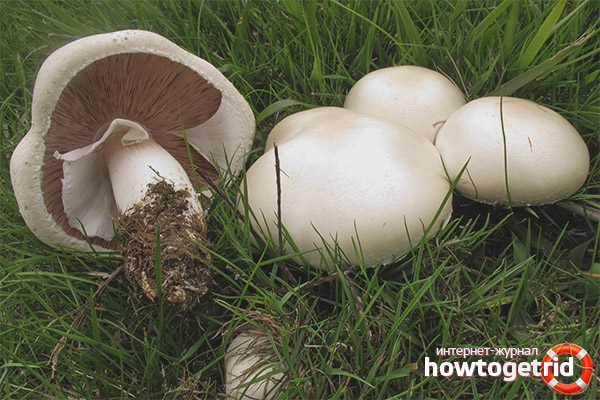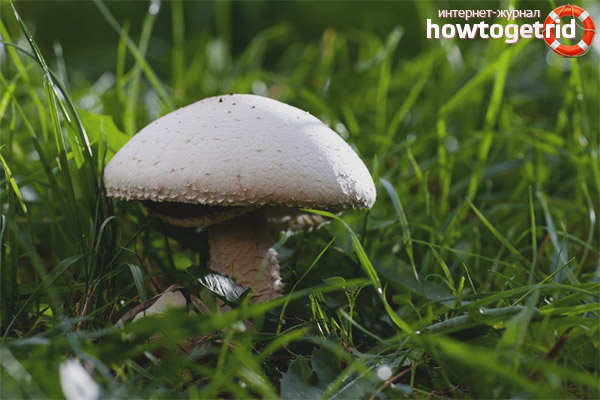The content of the article
Champignon is well known to many gourmets. The mushroom is very popular and is widely used in cooking. The word champignon has French roots and literally translates like a mushroom. And, despite the fact that a certain French charm and sophistication comes from this name, champignon is not a rare delicacy on our table. Very often this mushroom can be found on store shelves in fresh and frozen form. Edible champignons are very popular in our country, they are artificially grown in special greenhouses. However, not many people know that in nature there is a huge variety of champignons that grow in the natural environment. Field mushroom also belongs to this type of mushroom, which can be learned more from this article.
Characteristics of field champignon
It is a representative of one of 200 varieties of agaric mushrooms of the champignon family. It is considered one of the largest mushrooms of its kind. Champignon belongs to edible mushrooms, therefore, experts rank it in the third category according to classification.
In Russia, this mushroom is known under many names. Local mushroom pickers often call it sidewalk or sheep’s mushroom. Far beyond the borders of Russia, this mushroom has another unusual name. The British often call field mushroom "horse mushroom." The fact is that it can often be found in soil fertilized with horse manure among stables or horse pastures.
In young animals, the inside of the mushrooms has a denser white shade texture. However, the older the mushroom, the flesh becomes softer to the touch, with time its color acquires a yellowish color. If you damage the mushroom's head, then after a while its surface will turn yellow. The pulp has a peculiar aroma, gives a little anise or almond, the taste is sweet.
The leg of field champignon is quite smooth in texture. The older the mushroom becomes, the more its leg changes. Mature has a cylindrical shape, sometimes expanding at the base. Champignon legs can form up to 10 cm in height and up to 1.5 cm in width. In a mature mushroom, its inside becomes empty. The leg of the mushroom has the same color as the hat. A bilayer ring with a scaly texture at the bottom of the surface is formed at the top. The leg is quite easily separated from the mushroom cap.
Plants of field champignon
This variety of champignon mushrooms belongs to the organisms saprotrophs, therefore, it usually grows on humus soil flavored with organic substances. Field champignon usually likes to grow in grassy areas where there are no neighbors - trees. From this came the sonorous nickname - field mushroom. Indeed, the most favorite place of field champignons is forest edges without trees, clearings, park areas, roadsides along the edge of a forest road, pastures. Fans of mushrooms can find these mushrooms not only on flat terrestrial surfaces, but also often on the hillocks, where a stinging nettle plant grows wildly. It is almost impossible to find champignon under a tree, sometimes its habitat may be soil under spruce trees. Usually these mushrooms settle in a group: they grow next to each other, forming a semicircle. But sometimes they can be found alone, one at a time.
This variety of mushrooms spread throughout Russia and even in the Caucasus. Very often they can be found on the European continent. These mushrooms grow in a temperate northern climate. Experienced mushroom pickers know that you can look for field mushrooms with the advent of spring. Mushrooms begin to appear from the soil in early May and until the end of November. Of course, it all depends on the climatic conditions of their growth.
Champignon is truly considered a real decoration of any festive table. It can be called a delicacy of its kind, because it goes well with various types of dishes. However, it is important for inexperienced mushroom pickers to remember that champignon can be very easily confused with some poisonous relatives.
Edible and poisonous double mushrooms
At the same time, inexperienced mushroom pickers can also easily come across in the forest poisonous representatives of this mushroom family, which, like two drops of water, can resemble field champignon. The edible appearance has some similarities with a pale toadstool, which is often called mushroom mushroom pickers. Pale toadstool is very poisonous, therefore, it is necessary to collect mushrooms in the forest with great care. It is important to remember that the edible appearance is pink in the color of the plates, while the pale grebe is white in color. There are also two brown, smooth rings on the toadstool leg in a ripe state.
Video: how to distinguish mushroom champignon from a pale toadstool











Submit